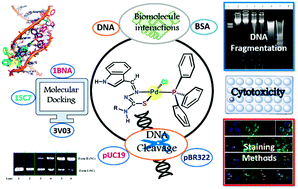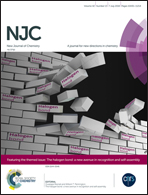Synthesis, structures and mechanistic pathways of anticancer activity of palladium(ii) complexes with indole-3-carbaldehyde thiosemicarbazones†
Abstract
New PdII complexes of the types [PdCl(L)(PPh3)] (1–5) and [Pd(L)2] (6 and 7) (HL = indole-3-carbaldehyde thiosemicarbazones, HL1–HL5) have been synthesized in order to ascertain the effect of substitution at the terminal nitrogen of thiosemicarbazones on the biological properties of their PdII complexes. The compounds were characterized by elemental analyses, and UV-visible, FT-IR, 1H NMR, 13C NMR, DEPT-135 NMR, 31P NMR, 1H–1H COSY, 1H–13C HSQC, 1H–13C HMBC, 1H–31P HMBC and mass spectroscopic techniques. The solid state structures of the ligand (HL3) and complexes (2–5 and 6) were determined by single crystal X-ray diffraction analysis. Spectroscopic and crystallographic studies revealed that thiosemicarbazone is coordinated to the PdII ion as a monobasic bidentate (NS−) ligand by forming a five membered ring. To determine the potential of the PdII complexes towards biomolecular interactions, additional experiments involving interaction with calf thymus DNA (CT DNA) and bovine serum albumin (BSA) were carried out. Further, the complexes cleaved DNA (pUC19 and pBR322) without any co-oxidant at pH 7.2 and temperature 37 °C. The effect of substitution on the DNA and BSA binding ability of the complexes was revealed through molecular docking studies. In addition, in vitro anticancer activity was examined by using MTT assay in three cancer cell lines (HepG-2, A549 and MCF7) and one normal cell line (L929). Complexes 4 and 5 which contain triphenylphosphine showed better activity (HepG-2) with an IC50 value of 22.8 and 67.1 μM respectively. The anticancer activity of the complexes was compared with that of the well-known anticancer drug cisplatin and it was inferred that complex 4 exhibited comparable activity. All the complexes displayed moderate anticancer activity against A549 and MCF7 cancer cell lines and less toxicity towards the normal cell line. The morphological changes assessed by staining methods and DNA fragmentation revealed that the cell death occurred by apoptosis.



 Please wait while we load your content...
Please wait while we load your content...